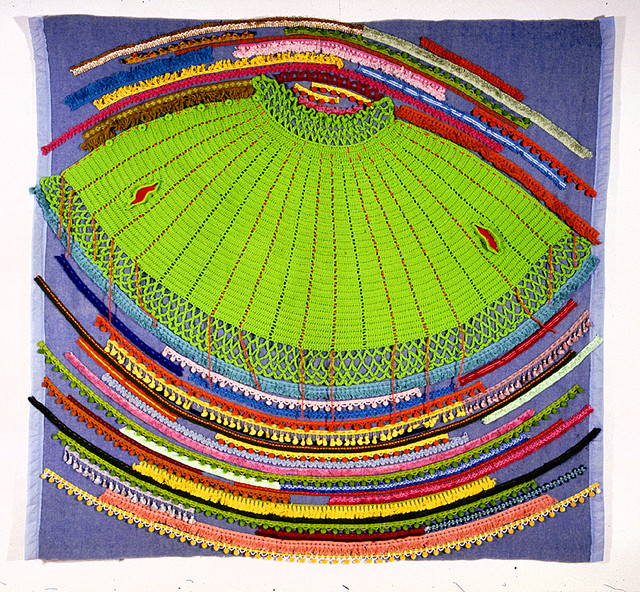Read Part One of the interview, where Sherri guides us in the process of healing through quiltmaking.

Dana: Do you explain the parallels between the quiltmaking process and the grief process in your workshops or with clients, or do you just let people have the experience?
Sherri: I bring it up in a matter of fact way. I don’t explain it too deeply. I might say a couple of things about the benefits, like I’ll invite them to be present in the process. I’ll say something like, “Pay attention to the way you’re forming these patterns, it can teach you a lot about what’s going on internally.” But, I want people to have their experience. As a facilitator, I don’t think of myself as a counselor. My role is just to be present and give guidance, in terms of the skill.
People are able to be grounded in the process of learning this new skill. My role is to teach them the skills and to be present to any kind of emotions that come up through the process.
A lot comes out in the workshops. Usually I’ll open and close the workshop with sharing and reflecting, and especially when the workshop is more than one day, they have time to think about reflections and come back, a lot comes out. Everyone is going through a transition, and the workshop becomes a community forum where people can share. That process is very grounding.
Dana: Do you always bring it back to healing, rather than focusing on learning the skills of quilting?
Sherri: Yes. It’s always about the process of healing. As an artist I can have an aesthetic judgment about their work, but that’s really of no importance. No one ever looks at what they’ve made and thinks “I don’t like the way this looks”. When people ask me what will look best, I encourage them to do what is pleasing to their eye, to use their intuition to create the piece aesthetically.
Dana: How did your quiltmaking evolve into the hands-on grieving and healing process of “passage quilting”?
Sherri: Passage Quilting evolved out of my practice as a quiltmaker and as an artist after 911 and around the Spring of 2002. I’ve made quilts by commission a lot, and people would hang them in their living room or whatever, but I got to a point where I was tired of creating just objects. I had a desire to do more service-oriented artwork.
People would come to me with clothes and things to make quilts, and it occurred to me how much meaning clothing and materials carry, the narrative that exists in them. I wanted to have more interaction with my clients and doing something more meaningful, so I made this conscious decision to move toward service-based rather than object-based work.
Dana:You said you wanted to get into service-oriented work. How did you get involved with healing and grief in particular?
Sherri: I made a conscious decision as I evolved as an artist to do social practice. There are so many different directions you can go to as an artist.
I had some difficulty with depression when I was younger, and when I started quilt making it was very healing for me. I wanted to interact with people, do stuff that connects to my life, and now that I feel more healed, I want to figure out ways that my creative work can do that for other people. It just made sense to me to go to healing, because that was what had driven my creative work.
I started with traditional quilts, but when I started the improvisational quilts, it became a healing process for me. When I became a professional artist, I had to start making decisions about what kind of work I was going to do. And I wanted to continue to do meaningful work.
Dana: What made you start improvisational quilting?
Sherri: I was always looking for a more free way of making quilts. I had all of these rules about quiltmaking, and I wanted to break out of that. Then I saw an exhibition –Who’d a Thought It? – very shortly after I started making quilts, of African American improvised quilts. It was the first time they had been exhibited in a museum, and that was the first time I’d ever seen that type of quilting. Improvised quilts are so alive and present. That had a profound influence on me.
I learned more through taking workshops, and later I started discovering things like how fabric can carry narrative, which is what led to Passage Quilting. The rhythm of intention became very fascinating to me. I became very fascinated by pattern-making and the intention and the presence that’s required for improvisation. As I’m making these quilts, I’m always learning something about myself and the way that I make patterns in my life.
Dana: Is there anything else you would like SevenPonds readers to know?
Sherri: The idea that anyone can do is really important. It can be as a community project, it doesn’t have to be done individually. Making one quilt can be a good project for communities and families to go through the process together and share those memories with other people.
Dana: Thank you so much for your time, Sherri!
Sherri: Thank you for including me; I really love what you are doing with SevenPonds, and I’m happy to be a part of it.

 An Interview with Sherri Lynn Wood
An Interview with Sherri Lynn Wood


 How Dare You Die Now!
How Dare You Die Now!
 Debating Medical Aid in Dying
Debating Medical Aid in Dying
 “Help Me, Helen”
“Help Me, Helen”














